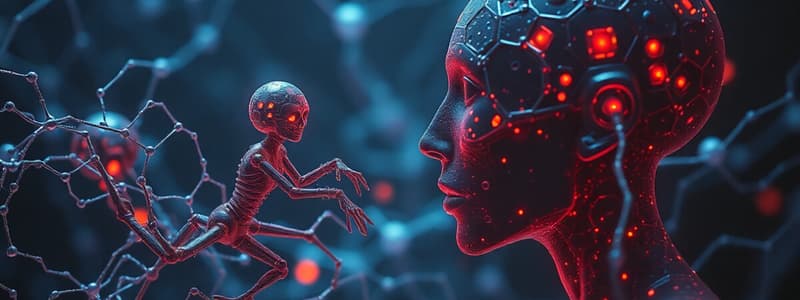Podcast
Questions and Answers
What does the introduction suggest about nanotechnology?
What does the introduction suggest about nanotechnology?
- It’s only useful for medical applications
- It’s fictional science
- It’s purely theoretical
- It’s an emerging technology with real-world applications (correct)
What is the primary focus of nanotechnology?
What is the primary focus of nanotechnology?
- Genetic engineering
- Working with entire cells
- Creating large devices
- Utilizing atoms and molecules at a small scale (correct)
Which of the following techniques is used in nanotechnology to manipulate materials?
Which of the following techniques is used in nanotechnology to manipulate materials?
- 3D printing
- Gene editing
- Top-down and bottom-up approaches (correct)
- Large-scale manufacturing
What is a nanorobot?
What is a nanorobot?
How can nanorobots help in disease detection?
How can nanorobots help in disease detection?
How can nanorobots reduce material waste in manufacturing?
How can nanorobots reduce material waste in manufacturing?
In which energy sector do nanorobots show significant promise?
In which energy sector do nanorobots show significant promise?
How do nanorobots assist in energy storage systems?
How do nanorobots assist in energy storage systems?
How do nanorobots improve thermoelectric devices?
How do nanorobots improve thermoelectric devices?
What role can nanorobots play in water purification?
What role can nanorobots play in water purification?
In soil remediation, how can nanorobots address pollution?
In soil remediation, how can nanorobots address pollution?
Which property of nanorobots aids in air pollution control?
Which property of nanorobots aids in air pollution control?
Which air pollutants can nanorobots mitigate effectively?
Which air pollutants can nanorobots mitigate effectively?
What is a promising use of nanorobots in material science?
What is a promising use of nanorobots in material science?
How do nanorobots contribute to responsive surfaces in material science?
How do nanorobots contribute to responsive surfaces in material science?
Match the following vocabulary words with their correct definitions:
Match the following vocabulary words with their correct definitions:
Flashcards are hidden until you start studying
Study Notes
Nanotechnology Overview
- The manipulation and utilization of matter at an atomic and molecular scale, typically less than 100 nanometers.
- Works by using top-down and bottom-up approaches.
Nanorobots
- Tiny machines designed to perform tasks at the nanoscale, often within the human body or in other intricate environments.
Potential Applications of Nanorobots
- Medicine: Disease detection, targeted drug delivery, surgery.
- Environmental cleanup: Water purification, soil remediation, air pollution control.
- Manufacturing: Material waste reduction, optimizing material distribution.
- Energy production: Enhance energy storage, improve thermoelectric devices.
- Material science: Create self-healing materials, develop responsive surfaces.
Key Concepts Related to Nanorobots
- Biomarkers: Molecular indicators of a biological state or condition, often used in disease detection.
- Self-healing materials: Materials engineered to repair themselves autonomously after damage.
- Thermoelectric devices: Devices that convert temperature differences directly into electrical voltage and vice versa.
- Self-assembly: A process by which molecules automatically organize themselves into a functional structure.
- Catalyze: To accelerate a chemical reaction, often crucial in nanorobots' functioning.
- Microbial remediation: The use of microorganisms to remove pollutants from the environment.
Studying That Suits You
Use AI to generate personalized quizzes and flashcards to suit your learning preferences.



